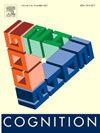Impact of conflicts between long- and short-term priors on the weighted prior integration in visual perception
IF 2.8
1区 心理学
Q1 PSYCHOLOGY, EXPERIMENTAL
引用次数: 0
Abstract
The prior distribution of values for a specific feature can be categorized as long- or short-term priors based on their respective learning durations. Studies have demonstrated that the visual system can integrate both priors through weighted averaging and then utilize the integrated prior to efficiently encode stimuli. It is unclear what determines the two priors' relative weights. To address this question, we arranged the orientations according to three distributions: natural, anti-natural, and natural with increased-amplitude distributions. The natural distribution mirrors the distribution of orientations in the natural world, so it does not conflict with the long-term prior; according to the Kullback-Leibler divergence analysis, the natural distribution had a higher conflict with the anti-natural distribution than with the natural distribution with increased amplitude. It was found that the cardinal bias — the orientation estimates are biased away from the cardinal orientations — was strongest in the natural distribution with increased amplitude but weakest in the anti-natural distribution. These results were accurately predicted by an efficient Bayesian observer model in which the prior is the weighted integration of the long- and short-term priors. Importantly, the weight of the short-term prior in the new prior decreased as the level of the conflict between the long- and short-term priors increased. Therefore, this study reveals that the visual system integrates the long- and short-term priors through weighted averaging, with the conflicting level between the two priors determining their relative weights in the integration prior. The integrated prior was used by visual systems to efficiently encode stimuli.
视觉感知中长期和短期先验冲突对加权先验整合的影响。
特定特征值的先验分布可根据各自的学习持续时间分为长期先验和短期先验。研究表明,视觉系统可以通过加权平均法整合两种先验值,然后利用整合后的先验值对刺激进行有效编码。目前还不清楚是什么决定了两种先验的相对权重。为了解决这个问题,我们将方向按照三种分布进行了排列:自然分布、反自然分布和振幅增加的自然分布。自然分布反映了自然界中的方向分布,因此它与长期先验并不冲突;根据库尔贝克-莱伯勒发散分析,自然分布与反自然分布的冲突要高于与振幅增加的自然分布的冲突。研究发现,在振幅增大的自然分布中,先验偏差(方向估计偏离先验方向)最强,而在反自然分布中则最弱。有效的贝叶斯观察模型可以准确预测这些结果,在该模型中,先验值是长期和短期先验值的加权整合。重要的是,短期先验在新先验中的权重随着长期先验和短期先验之间冲突程度的增加而降低。因此,这项研究揭示了视觉系统是通过加权平均来整合长期先验和短期先验的,两个先验之间的冲突程度决定了它们在整合先验中的相对权重。视觉系统利用整合先验对刺激进行有效编码。
本文章由计算机程序翻译,如有差异,请以英文原文为准。
求助全文
约1分钟内获得全文
求助全文
来源期刊

Cognition
PSYCHOLOGY, EXPERIMENTAL-
CiteScore
6.40
自引率
5.90%
发文量
283
期刊介绍:
Cognition is an international journal that publishes theoretical and experimental papers on the study of the mind. It covers a wide variety of subjects concerning all the different aspects of cognition, ranging from biological and experimental studies to formal analysis. Contributions from the fields of psychology, neuroscience, linguistics, computer science, mathematics, ethology and philosophy are welcome in this journal provided that they have some bearing on the functioning of the mind. In addition, the journal serves as a forum for discussion of social and political aspects of cognitive science.
 求助内容:
求助内容: 应助结果提醒方式:
应助结果提醒方式:


